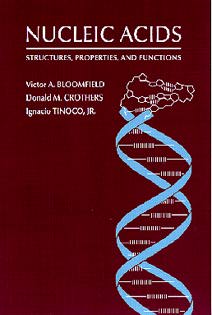
Nucleic Acids: Structures, Properties and Functions
Nucleic Acids presents an up-to-date and comprehensive account of the structures and physical chemistry properties of nucleic acids, with special emphasis on biological function. With a targeted audience of 1)molecular biologists, 2)physical biochemists, and 3)physical chemists, the book has been carefully organized to reach three different audiences while requiring only introductory physical chemistry and molecular biology as prerequisites.
Summary
Nucleic Acids presents an up-to-date and comprehensive account of the structures and physical chemistry properties of nucleic acids, with special emphasis on biological function. With a targeted audience of 1)molecular biologists, 2)physical biochemists, and 3)physical chemists, the book has been carefully organized to reach three different audiences while requiring only introductory physical chemistry and molecular biology as prerequisites. Nucleic Acids will serve as a textbook in physical biochemistry and biophysical chemistry classes, as well as a supplemental text in courses on nucleic acid biochemistry or molecular biology, and as a personal reference for students and researchers in these fields.
Key Features
- Organized according to a systematic consideration of techniques used in the study of nucleic acid structure and properties.
- Key topics–such as protein-DNA and protein-drug complexes, conformational transitions, characterization of nucleic acids by gel and solution techniques, and behavior of supercoiled DNA–are covered in great detail as veritable mini-monographs.
- Heavily illustrated with diagrams, graphs, and molecular structures, including nearly 2 dozen color figures.
- Includes numerous figures, tables and an extensive bibliography to facilitate use as a reference volume.
Resources
Table of Contents
1. Introduction
2. Bases, Nucleosides and Nucleotides
3. Chemical and Enzymatic Methods
4. Nucleic Acid Structures from Diffraction Methods
5. Structure and Dynamics by NMR
6. Electronic and Vibrational Spectroscopy
7. Theoretical Methods
8. Conformational Changes
9. Size and Shape of Nucleic Acids in Solution
10. Supercoiled DNA
11. Interaction of Nucleic Acids with Water and Ions
12. Interaction and Reaction with Drugs
13. Protein-Nucleic Acid Interactions
14. Higher Order Structure
Index
Reviews
“It was a pleasure to review this book, which is a suitable textbook for graduate courses in physical biochemistry. It provides an update for the widely used text by Cantor and Schimmel…I would recommend this text for graduate classes in physical biochemistry.”
-Journal of the American Chemical Society (2000, 122 (46), pg. 11570)
“Overall, this is an excellent book that should find use in graduate level biophysical chemistry and physical biochemistry courses and as a reference for physical chemists, physical biochemists, and molecular biologists.”
-Journal of Medicinal Chemistry (2000, Vol. 43, No. 24, pg. 4721)
“This work effectively closes a gap in the scientific literature where a comprehensive, updated book has been long overdue. Written by three recognized worldwide experts in the field, the book acts as an up-to-date encyclopedia of nucleic acids with an emphasis on implications for biological functions.”
-Drug Discovery Today
